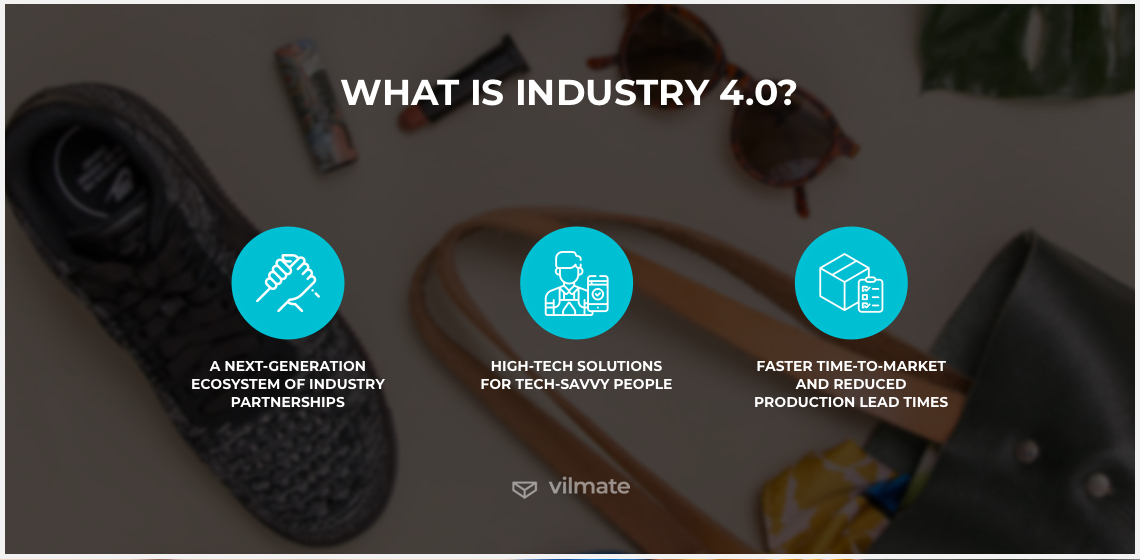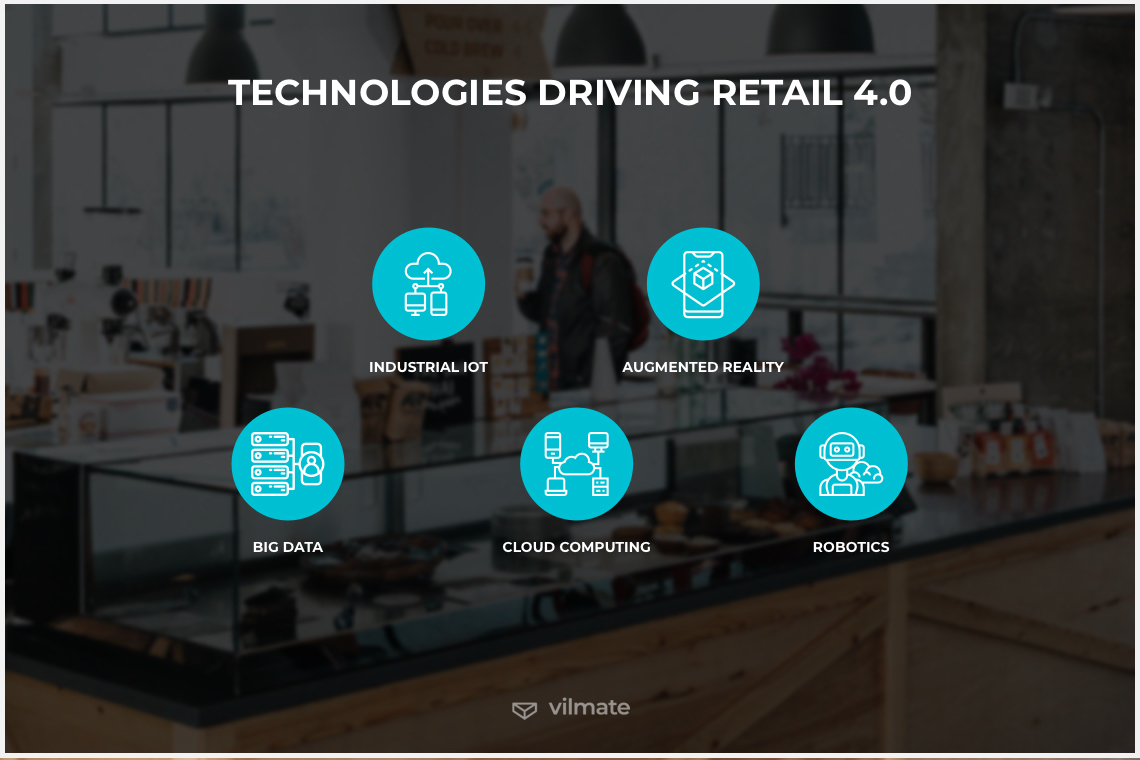The fourth industrial revolution has filled the need for change within a number of industries. Among other things, these transformative processes gave rise to Retail 4.0 that offers a clear and concise roadmap to the current and upcoming changes in the retail world.
This combination of two digits (4.0) has recently become a universal marker that is used to signal discussions about the future of business, innovation, and society as a whole. Mainstream and meme-like, Industry 4.0 (or I4.0) is now synonymous with the digitization of the business processes, and the result is an ever more connected, globalized world. The I4.0 world uses cutting-edge technologies to connect people with information and services. Let’s dig deeper into the topic of 4.0 phenomena and see how the fourth industrial revolution has affected the retail and what technologies are now in use to support it.
What is Industry 4.0?
The Industry 4.0 concept refers to the fourth industrial revolution in manufacturing. It was introduced at the Hannover Fair in Germany in 2011 and provides prescriptions about how production processes can be controlled using new technological innovations.
Industry 4.0 has become a buzzword in the business and organizational world. Aiming at the continuous improvement of areas of performance such as flexibility, productivity, and quality, I4.0 makes manufacturers and businesses more efficient and agile in their work process.

-
A next-generation ecosystem of industry partnerships. The right enterprise resource planning software solution is one of the fundamental enablers of Industry 4.0. An ERP system can aggregate and contextualize manufacturing organizations’ ever-growing volume of data into a single view of processes and systems. Industry 4.0 requires a highly intelligent, hyper-connectable, and scalable solution that combines RPA analytics with financial planning capabilities. ERP fits the requirements perfectly.
-
High-tech solutions for tech-savvy people. Industry 4.0 is all about liberating employees from the mundane routine through digitization. The last decade has seen tremendous advances in technological innovations. New ways to manage our work lives through technology emerged, and I4.0 unlocks opportunities and more freedom for people to do their best work. As a result, the more Industry 4.0 technologies a company adopts, the more benefits the business or organization will enjoy.
-
Faster time-to-market and reduced production lead times. Industry 4.0 brings surgical precision to the timing of product development and delivery, increasing profitability and minimizing time-to-market and lead time. Due to the availability of top-notch technologies, fast R&D cycles are becoming commonplace across the industries. Real-time data tracking and production adjustments, just-in-time schedules, and delivery enable organizations to work smarter. Products are developed for current market conditions with an eye on future industry demands.
How the fourth industrial revolution changed the retail
Industry 4.0 removes data barriers. Thus, it is swiftly becoming a way for industries — and in the first place, the manufacturing sector — to encourage data-driven decision-making and improve overall profitability and competitiveness. With time, the I4.0 discourse has become much more mainstream and universal, so that to give rise to a range of neologisms in the areas of work, operations, education, marketing, management, society, innovation, as well as numerous industry-specific terms like Retail 4.0.
The term Retail 4.0 has appeared to explain an abundance of trends and developments in the global retail sector. Often referred to as “intelligent digital,” it focuses on bringing innovation to customer experience and reconsidering the role of the store in merchant-customer relationships. From the 2010s and until today, retailers have been working hard to make the following aspects inherent to the retail industry of a new era:
- seamless omnichannel commerce experiences
- personalization of customer interactions
- responsive merchandising
- consistent customer and product information
- enhanced delivery performance
Positive changes are meant to be observed across all touchpoints. Retail 4.0 is a driver of those changes. It allows sellers to apply predictive analytics and various advanced technologies, which we’ll discuss below, for customer behavior to introduce more value to merchants through the digital experience, better shape the road map and optimize the customer journey.
Technologies driving Retail 4.0
Nowadays, competition is getting ever fiercer in omnichannel commerce. So, companies have to develop capabilities that would let them compete with their rivals on a regional, national, or global scale. Access to technology enables retailers of any size to pave the way for better shopping experiences. They are experimenting with carts that can check customer’s groceries, mobile apps that can check you out, sparing the inconvenience of standing in line, or robots that can actually replace some of the store workers, to name a few.
Transitioning to next-generation commerce requires that retailers consider all possible options and assess their capabilities before investing their resources in something that, in the long run, will hardly benefit the business. For your guidance, the following technologies have the power to enable retailers to understand customer purchase behavior and respond to the market proactively.

Big data
In 2020, it is not customers walking through the doors of your brick-and-mortar store who shape the future of your retail business. Due to Retail 4.0, the brand itself can accurately follow the trail of its customers whenever they go and, meanwhile, gather valuable personal data.
Big data is an immense volume of data that can be used to define patterns and trends, usually associated with human behavior. In retail, big data is collected to drive personalization of purchasing experience. User log-ins, IP addresses, credit card transactions, shopping history, and to a certain extent, other data gathered through loyalty programs are all a great source of unbiased information to be taken advantage of by merchants.
In-depth data analysis will help identify what parts of your business need improvement, be it staffing, inventory management, point of sale processes, or the delivery of goods and services. It can also help to trace the customer journey and thus understand why decisions are being made, what the best ways to reach customers are, and how to use this data to increase one’s ROI.
Industrial IoT
Industrial IoT has entered the retail industry as an integral part of the IT infrastructure and keeps constantly innovating it. The Internet of things is closely related to logistics, supply chain management, and inventory management, which form the retail ecosystem. So, now, the retail industry keeps trying and realizing the potential of IIoT to be fulfilled across different sectors.
IoT is becoming a big thing within Retail 4.0. Over the years, more and more enterprises have been adding IoT features to their warehouse devices and platforms. In the near future, IoT is bound to become another key enabler of retail industry growth. IoT makes it possible to monitor the smallest interactions between customers and a merchant. With IoT sensors, devices can interact with each other, updating the current data. Having data up to date, merchants can rely on predictive maintenance of equipment, as well as reliable tracking of inventory levels of stores and warehouses.
It promises an exciting future for the industry that will drive improvements in quality, business efficiencies, and customer satisfaction, ensuring a more secure and efficient business environment. We are optimistic that IIoT will become the new business standard in the coming years and, when implemented, will transform the way people go shopping.
Cloud computing
Cloud computing services offer numerous advantages to businesses across industries, including retail. That is why, no doubt, the cloud is at the forefront of an undergoing paradigm shift. Cloud services have enabled the relocation of essential store operations from a central data center to a remote location, thus enhancing flexibility, responsiveness, and intelligence of business processes.
Cloud computing enables a genuinely transparent approach to running a business in retail 4.0. It opens the way for frictionless commerce as a method of using data from both physical and digital sources to integrate buying opportunities and store the big data generated from these channels. The status of consignments, high or low inventories, stock-outs, product updates, and returns all are supported through the cloud. Given the frictionless commerce, customers can rely on the vendor to sell their products and experience no surprises. With the flexibility and portability of cloud services, organizations can efficiently "lean" operations, as well as make better use of existing IT infrastructure.
The cloud has an online nature, which helps promote the security of cloud-based data-driven processes. Within the framework of frictionless retail, however, cloud computing becomes a natural extension of the physical world and of human trading activities, as it is integrated into supply chains. Empowered by the cloud, retail 4.0 starts to exist irrespective of geography or time zones, on-demand, with no friction or wait-times, without barriers to interaction, open to innovation and promoting it.
Augmented reality
We’ve seen a significant expansion of the VR / AR market over the last several years. As part of Industry 4.0, virtual and augmented reality technologies are now used in retail, too. Not only AI and IoT are transformative for experiential retail, but augmented reality is also picking up the pace. It is retail that has taken the lead in using AR to showcase products for sale.
The role of showcasing cannot be overemphasized when it comes to manufacturing, designing, and developing products, as well as convincing customers to purchase them. Currently, online retailers are taking advantage of augmented reality and 3D technologies to change the way people shop, either online or in-store. Proving the point, Gartner predicted that 100 million customers would shop in AR by 2020. Meanwhile, according to IDC, the global spendings on AR/VR in retail in 2020 are expected to be the biggest among the commercial industries reaching $1.5 billion.
Major retailers already use augmented reality to improve the sales process and their tools are becoming more sophisticated and interactive. Among them are Sephora that offers magic mirrors in stores and mobile apps that help consumers visualize how different products will look on them, IKEA that uses AR to let customers place and manipulate catalog items at scale, and ASOS that demonstrates what clothing can look like on different body types.
Robotics
The potential of Industry 4.0 is effectively harnessed at the very point where humans combine with technology. Thus, autonomous robots are becoming mainstream as they perform wide-ranging tasks, such as hauling freight, warehouse management, or customer service. And by doing so, they help retailers improve employee productivity and inventory accuracy.
As vision systems improve, especially with regard to location awareness and integration with smart mobile devices, industrial robots might become less rigid and more agile, with greater potential to augment human workers’ efficiency in difficult and high-stress situations. Currently, robotics in retail 4.0 is not yet a fully developed innovation but already more than a nice-to-have. Robots are capable of inducing positive transformations in-store operations, and that’s the fact, which is hard to deny.
Amazon uses robots for their behind-the-scenes work in warehouses, Walmart lets their autonomous mobile robots roam up and down store aisles to help keep things under control in there, while Domino’s is developing and testing their own robots that are responsible for food delivery. So, with robotics technologies of different kinds, retailers can keep improving their capabilities, so they can be more efficient and responsive to customer demands, and cut down on labor costs, too.
Conclusion
Most of the above technological drivers of retail 4.0 are in the early stages of development. However, we cannot but admit a trend for 4.0 technologies is visible across all channels, and it is only a matter of time before we see them taking off.
Therefore, the time to start adapting to the realities of retail 4.0 is now. Creating new infrastructures and updating existing ones must be part of enterprises’ strategies for executing in an environment that is constantly changing. If everyone makes a competitive play for cutting-edge technology with the potential to significantly improve their sales figures, we can be sure that the multiple subsequent positive outcomes for customers will follow.

© 2020, Vilmate LLC




